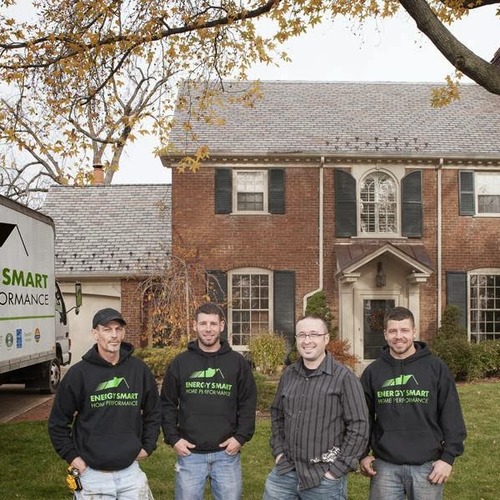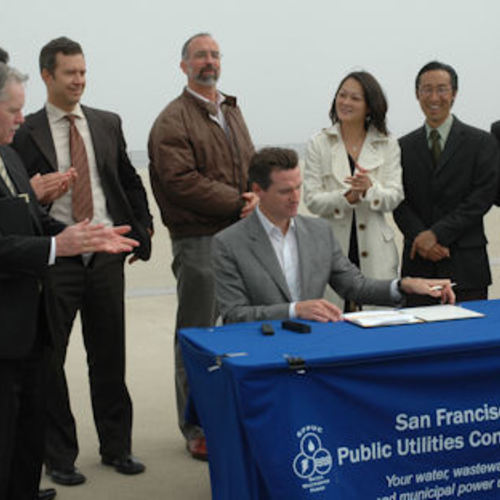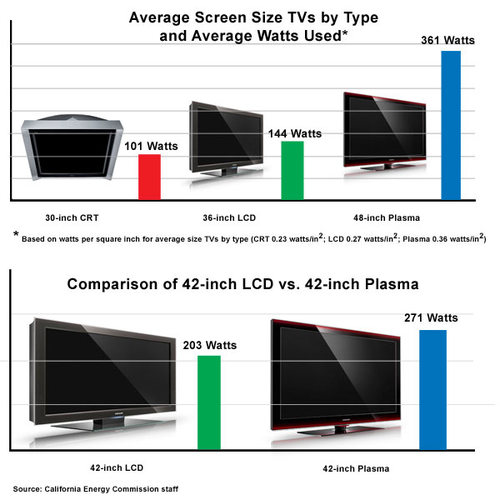
I’m writing this from San Francisco, where I’ve been at the West Coast Green Conference. This is the fourth year of the event–the nation’s largest green building conference and trade show focused exclusively on residential applications. It was in the Fort Mason Center, a sprawling, ex-military base with large, daylit buildings that are now used for exhibitions, and assorted meeting spaces throughout other buildings in the complex. It’s right on the water, just west of Fisherman’s Wharf–looking out on the Golden Gate Bridge.
As with many conferences, there is far more going on than one can take advantage of. Between my speaking commitments–one session on innovative new green building products and another, more informal, “fireside chat” conversation with the editor of Sustainable Industries magazine–and the time I spent at our GreenBuildingAdvisor.com booth (which we powered with a bicycle generator), I didn’t have a lot of time to attend sessions. But one that I did attend focused on the importance of carrying out efficiency measures on homes before spending money on the higher-profile features like solar panels. This is a theme that I’ve included in many of these columns.
The presentation was by Matt Golden, who is president of a Bay Area business, Sustainable Spaces. His company, which employees over 60 people, carries out “home performance contracting.” Their services include comprehensive energy audits and a wide range of measures to lower a home’s energy consumption and improve comfort and indoor air quality (by eliminating moisture and mold problems, for example).
There are lots of home performance contracting companies around the country. Sustainable Spaces is one of the best, with its comprehensive building assessments, innovative computer modeling of improvement options, vertically integrated services (all the work is done by their well-trained crews), and strong foundation of building science.
In this presentation, Matt stressed the importance of dealing with efficiency before putting money into solar and other high-profile renewable energy systems. Many homeowners come to Sustainable Spaces wanting solar water heating or solar-electric (photovoltaic) systems, but the company steers them first toward improvements that save far more money–at lower cost–through added insulation, properly sealed ducts, upgraded heating systems, and the like.
By addressing efficiency first, homeowners can also end up with significantly smaller and more affordable solar energy systems–if they do install solar. This also holds true with heating and cooling systems: by reducing heating and cooling loads, these mechanical systems can be downsized, reducing costs.
This is a message that Matt has helped to advance nationally in the policy arena through the nonprofit organization he co-founded this year in Washington, DC: Efficiency First. Now with over 500 members (mostly home performance contracting firms) in 44 states, Efficiency First has been working actively with legislators, including Vermont’s Representative Peter Welch, and federal agencies to push for legislation and policies that will use federal (taxpayer) funding in the most cost-effective way to address home energy use.
Efficiency First–and Matt’s company–argue that home performance contracting should follow a three-phase “loading order.” The first is addressing fundamentals (insulation, air sealing, duct sealing, lighting, appliances, water conservation, plug loads, and behavior); collectively, these efforts can reduce energy use by 20-40%. Second, after reducing loads, “major systems,” including heating, cooling, ventilation, and water heating, can often be downsized. Third, renewables should be considered, including photovoltaics, solar thermal (both water heating and space heating), wind, and rainwater harvesting.
When it comes to reducing carbon emissions–the ultimate goal according to climate scientists–Matt reported that appropriate efficiency measures in buildings save about $40 for every ton of carbon that is no longer emitted (in other words, we get paid for reducing emissions), while solar electric systems cost about $24 per ton of reduced carbon emission. If we do both–and he suggests that both are needed–we can use the economic savings from efficiency to pay for the economic costs of renewables. He doesn’t argue that we should skip the solar options, but that both should be part of an integrated approach to home performance contracting.
Efficiency first is a compelling mantra that we should all pay heed to.
I invite you to share your comments on this blog. You can also follow my musings on Twitter.
Weekly Newsletter
Get building science and energy efficiency advice, plus special offers, in your inbox.















10 Comments
Start at the top
Alex, you have highlighted the proper order when considering home efficiency improvements. Air sealing, starting with attic bypasses should be at the top of every list. A typical attic allows reasonable access for sealing along top plates, electrical wires, soffits, flues, plumbing stacks and light fixtures. After the air sealing, insulation can be added to code levels or beyond.
The next move is to address air leakage for the rest of the building envelope and insulate where there is no or little insulation. The exposed portion of a building foundation is often uninsulated and is a major heat sink. Wall insulation levels should be checked and improved if deemed cost effective. A great time to upgrade wall insulation is when siding is due for replacement, 2 or more inches of rigid will add significant R-value and greatly reduce thermal bridging. If the wall cavity has no insulation, blow-in is easily added while residing.
HVAC would be next on my list but with the building envelope improved the return on investment (ROI) will have changed for the heating and cooling equipment. If the furnace or AC unit is due for replacement, upgrade to a 95% furnace with ECM fan and a high SEER AC if the system is forced air.
By making these changes I cut the gas heating bill for our 1978 built rambler in half, from a bit over 4 Btu/sf/hdd to slightly over 2. I should add, I live in a cold climate, Minneapolis, MN (7876 hdd).
Efficiency
Really glad to see this article as it pinpoints a lot about what goes on in Austin TX. Solar is a major buzz word here and most people have no assessment of their window, insulation, or HVAC performance. I love conservation and it needs to be on the forefront of homeowner's minds: this is good for business too because it is affordable to upgrade windows, doors, attics etc compared with adding solar to a building that is essentially bleeding. Thanks, Doug
the good word
if there is a silver bullet to be had, efficiency is as close as it gets.
I just wish it were on the tongues of more bloggers, pundits, policy makers and consultants. I suppose that overall efficiency is far less sexy (and provides far less returns to the org offering such) than solar or whatever.
Similarly, there are solar conversations taking place that are stoked by the polarized moronic comments of a 1000 casual observers.
I want to get involved, help, advocate...any advice?
Efficiency in the face of falling Solar costs
I have been wondering what the effects of falling cost of solar panels might have on the incentives to do efficiency upgrades. If solar prices keep falling, then the comparable ROI of efficiency upgrades will fall in proportion. Potentially, there could even be a cross-over point someday in the future where it is cheaper to go solar than to insulate, etc.. Or, am I missing something here?
Yup, you're right
Designers of zero-energy buildings analyze potential measures as you suggest, Ron. Once any proposed measure becomes more expensive than PV, it's time to stop improving the envelope and start adding PV.
Green building lessons learned....
Five years ago, I did a massive remodel on my family home.
We installed a 2.5 Kwh PV system, solar HW, tankless backup WH, radiant floor heat w/ a 90% efficient boiler, Evaporative cooler, top-quality Low E windows, recycled Douglas Fir trim, cabinets, and doors, FSC certified cherry for kitchen cabinets, SIP panels on the addition, Trex decking, Low VOC stains, a Radiant Barrier, and low flow fixtures. Top quality Green Home!...featured in Natural Home magazine under the title "Sustainable in the Sierras"
And our home burns 1500 gallons of propane a year! And it can be quite uncomfortable in various places! What gives? We failed...we did not produce a green home and we bought all the products! Yes, we have now had the house performance tested and will likely have to spend another 10-20 thousand dollars correcting all the mistakes.
Efficiency must be first in the green building movement!
Conrad, please contact me
Conrad,
I'd love it if you could write up your story for GBA in more detail — perhaps as a guest blog. It sounds like many readers would benefit from learning more about the lessons you're talking about.
Please contact me if you're interested:
[email protected]
Thanks!
Martin Holladay, senior editor
But Martin....
Yes, as PV costs come down, it will certainly be more attractive and more feasible to sell to homeowners.
But we must remember that green building in not just about energy efficiency....it is also about comfort and health. Improving the envelope, adding good ventilation, reducing duct leakage, right sizing HVAC equipment, reducing pressure differences in the home, testing combustion appliances, etc, etc....all will create a more comfortable, healthier indoor environment....and energy conservation also includes heating loads, which will be reduced by everything above.
I just don't think we need to start with PV, no matter the costs.
I couldn't agree more
Conrad,
Fortunately, there's no incompatibility between what I wrote and what you wrote. The average house is far from having an optimized building envelope. So we have a long way to go with improved air tightness, better insulation, and better windows before we come close to measures that are as expensive as PV. That's why PV is always the last step, not the first.
But, if we do reach the point I'm talking about — and Passivhaus builders do reach that point — it makes little sense to add insulation on top of insulation until the insulation is so thick that the it becomes more expensive than PV. In other words, you don't want to install $5,000 of insulation to save $30 a year on your heating bill. (These are arbitrary numbers intended to drive home my point.)
Yes, I agree....
Thanks Martin. I think we do agree.
Essentially I am frustrated with my own mistakes. I can build a beautiful home, but I have so much to learn about building an energy efficient home. I tried to buy sustainability as opposed to achieving sustainability through hard, dirty work. And I think the green building movement is being overly influenced by manufacturers with fat marketing budgets....and government and utility companies giving rebates for the 'silver bullets'.
I'd love to talk about the article idea....it is a little complicated.
Log in or create an account to post a comment.
Sign up Log in